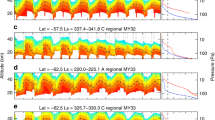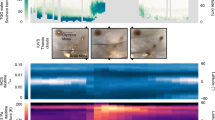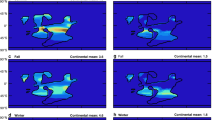Abstract
The wave of darkening in the Martian springtime, which some say may have a biological explanation, can be explained in terms of windblown dust.
This is a preview of subscription content, access via your institution
Access options
Subscribe to this journal
Receive 51 print issues and online access
$199.00 per year
only $3.90 per issue
Buy this article
- Purchase on Springer Link
- Instant access to full article PDF
Prices may be subject to local taxes which are calculated during checkout
Similar content being viewed by others
References
Pollack, J. B., Greenberg, E. H., and Sagan, C., Planet. Space Sci., 15, 817 (1967).
Kuiper, G. P., Astrophys. J., 125, 307 (1957).
Dollfus, A., Ann. d'Astrophys., Suppl. No. 4 (1957).
Sagan, C., Biology and the Exploration of Mars (edit. by Pittendrigh, C. S., Vishniac, W., and Pearman, J. P. T.) (National Academy of Sciences, Washington, 1966).
Sharonov, V. V., Priroda Planet, 507 (Moscow, 1958).
Rea, D. G., Nature, 201, 1014 (1964).
Bagnold, R. A., The Physics of Blown Sand and Desert Dunes (Methuen, London, 1941).
Ryan, J. A., J. Geophys. Res., 69, 3759 (1964).
Sagan, C., and Pollack, J. B., Smithson. Astrophys. Obs. Spec. Rep., 255 (1967).
Neubauer, F. M., J. Geophys. Res., 71, 2419 (1966).
Gierasch, P., and Goody, R. M., Planet. Space Sci., 15, 1465 (1967).
Leovy, C., Icarus, 5, 1 (1966).
Wen Tang, Planetary Meteorology, GCA Corp. Rep. No. NASw-1227 (1967).
de Vaucouleurs, G., The Physics of the Planet Mars (Faber and Faber, London, 1954).
Kuiper, G. P., Comm. Lunar Planet. Lab. Univ. Arizona, 2, 79 (1964).
Sinton, W. M., and Strong, J., Astrophys. J., 131, 459 (1960).
Ives, R. L., Bull. Amer. Meteorol. Soc., 28, 168 (1947).
Sinclair, P. C., Mon. Weather Rev., 22, 8 (1964).
Bagnold, R. A., The Physics of Blown Sand and Desert Dunes, 76 (Methuen, London, 1941).
Gierasch, P., and Goody, R. M., Planet. Space Sci., 16, 615 (1968).
Morrison, D., Sagan, C., and Pollack, J. B., Icarus (in the press).
Slipher, E. C., The Photographic Story of Mars (edit. by Hall, J. S.) (Sky Publ. Corp. Cambridge, Mass. and Northland Press, Flagstaff, Arizona, 1962).
Pollack, J. B., and Sagan, C., Smithson. Astrophys. Obs. Spec. Rep. 258 (1967); Space Sci. Rev. (in the press).
Focas, J. H., Ann. d'Astrophys., 24, 309 (1961).
Dollfus, A., Ann. d'Astrophys., 28, 722 (1965).
Pollack, J. B., and Sagan, C., Icarus, 6, 434 (1967).
Sagan, C., and Pollack, J. B., Nature, 212, 117 (1966).
Author information
Authors and Affiliations
Rights and permissions
About this article
Cite this article
SAGAN, C., POLLACK, J. Windblown Dust on Mars. Nature 223, 791–794 (1969). https://doi.org/10.1038/223791a0
Received:
Issue Date:
DOI: https://doi.org/10.1038/223791a0
This article is cited by
-
The Effect of Air Density on Sand Transport Structures and the Adobe Abrasion Profile: A Field Wind-Tunnel Experiment Over a Wide Range of Altitude
Boundary-Layer Meteorology (2014)
-
Geology of terrestrial planets with dynamic atmospheres
Earth, Moon, and Planets (1994)
-
Triton's streaks as windblown dust
Nature (1990)
-
Aeolian processes on Venus
Earth, Moon, and Planets (1990)
-
Aeolian Deposition in Martian Craters
Nature Physical Science (1972)
Comments
By submitting a comment you agree to abide by our Terms and Community Guidelines. If you find something abusive or that does not comply with our terms or guidelines please flag it as inappropriate.



